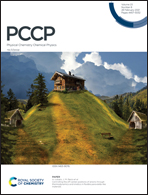Mixing divalent ionic liquids: effects of charge and side-chains†
Abstract
We have prepared novel divalent ionic liquids (ILs) based on the bis(trifluoromethylsulfonyl)imide anion where two charged imidazolium groups in the cations are either directly bound to each other or linked by a single atom. We assessed the influence of the side-chain functionality and divalency on their physical properties and on the thermodynamics of mixing. The results indicate that shortening the spacer of a divalent IL reduces its thermal stability and increases its viscosity. Mixtures of divalent and monovalent ILs show small but significant deviations from ideality upon mixing. These deviations appear to depend primarily on the (mis)match of the nature and length of the cation side-chain. The non-ideality imposed by mixing ILs with different side-chains appears to be enhanced by the increase in formal charge of the cations in the mixture.

- This article is part of the themed collection: 2021 PCCP HOT Articles


 Please wait while we load your content...
Please wait while we load your content...